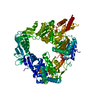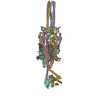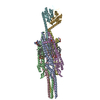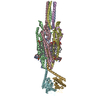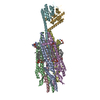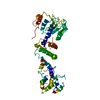+Search query
-Structure paper
| Title | Structure and mechanism of the Zorya anti-phage defence system. |
|---|---|
| Journal, issue, pages | Nature, Vol. 639, Issue 8056, Page 1093-1101, Year 2025 |
| Publish date | Dec 11, 2024 |
 Authors Authors | Haidai Hu / Philipp F Popp / Thomas C D Hughes / Aritz Roa-Eguiara / Nicole R Rutbeek / Freddie J O Martin / Ivo Alexander Hendriks / Leighton J Payne / Yumeng Yan / Dorentina Humolli / Victor Klein-Sousa / Inga Songailiene / Yong Wang / Michael Lund Nielsen / Richard M Berry / Alexander Harms / Marc Erhardt / Simon A Jackson / Nicholas M I Taylor /       |
| PubMed Abstract | Zorya is a recently identified and widely distributed bacterial immune system that protects bacteria from viral (phage) infections. Three Zorya subtypes have been identified, each containing ...Zorya is a recently identified and widely distributed bacterial immune system that protects bacteria from viral (phage) infections. Three Zorya subtypes have been identified, each containing predicted membrane-embedded ZorA-ZorB (ZorAB) complexes paired with soluble subunits that differ among Zorya subtypes, notably ZorC and ZorD in type I Zorya systems. Here we investigate the molecular basis of Zorya defence using cryo-electron microscopy, mutagenesis, fluorescence microscopy, proteomics and functional studies. We present cryo-electron microscopy structures of ZorAB and show that it shares stoichiometry and features of other 5:2 inner membrane ion-driven rotary motors. The ZorAB complex contains a dimeric ZorB peptidoglycan-binding domain and a pentameric α-helical coiled-coil tail made of ZorA that projects approximately 70 nm into the cytoplasm. We also characterize the structure and function of the soluble Zorya components ZorC and ZorD, finding that they have DNA-binding and nuclease activity, respectively. Comprehensive functional and mutational analyses demonstrate that all Zorya components work in concert to protect bacterial cells against invading phages. We provide evidence that ZorAB operates as a proton-driven motor that becomes activated after sensing of phage invasion. Subsequently, ZorAB transfers the phage invasion signal through the ZorA cytoplasmic tail to recruit and activate the soluble ZorC and ZorD effectors, which facilitate the degradation of the phage DNA. In summary, our study elucidates the foundational mechanisms of Zorya function as an anti-phage defence system. |
 External links External links |  Nature / Nature /  PubMed:39662505 / PubMed:39662505 /  PubMed Central PubMed Central |
| Methods | EM (single particle) |
| Resolution | 2.07 - 3.6 Å |
| Structure data | EMDB-18747, PDB-8qy7: EMDB-18750, PDB-8qyc: EMDB-18751, PDB-8qyd: EMDB-18754, PDB-8qyh: EMDB-18756, PDB-8qyk: EMDB-18766, PDB-8qyy: EMDB-18948, PDB-8r68: |
| Chemicals | 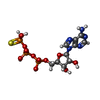 ChemComp-AGS: 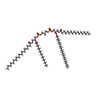 ChemComp-CDL:  ChemComp-CA:  ChemComp-PEE:  ChemComp-PLM: 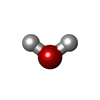 ChemComp-HOH: |
| Source |
|
 Keywords Keywords | ANTIVIRAL PROTEIN / Nuclease / membrane protein |
 Movie
Movie Controller
Controller Structure viewers
Structure viewers About Yorodumi Papers
About Yorodumi Papers






